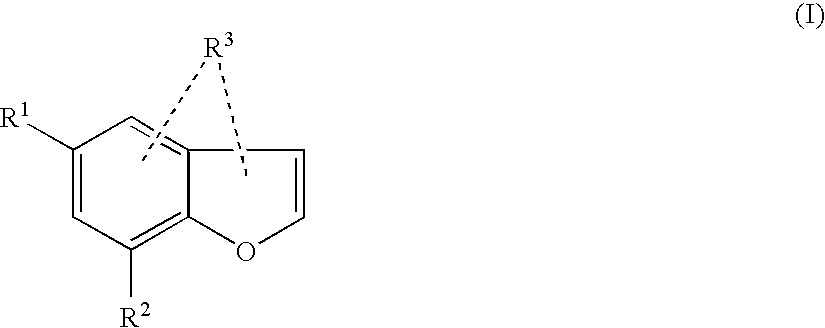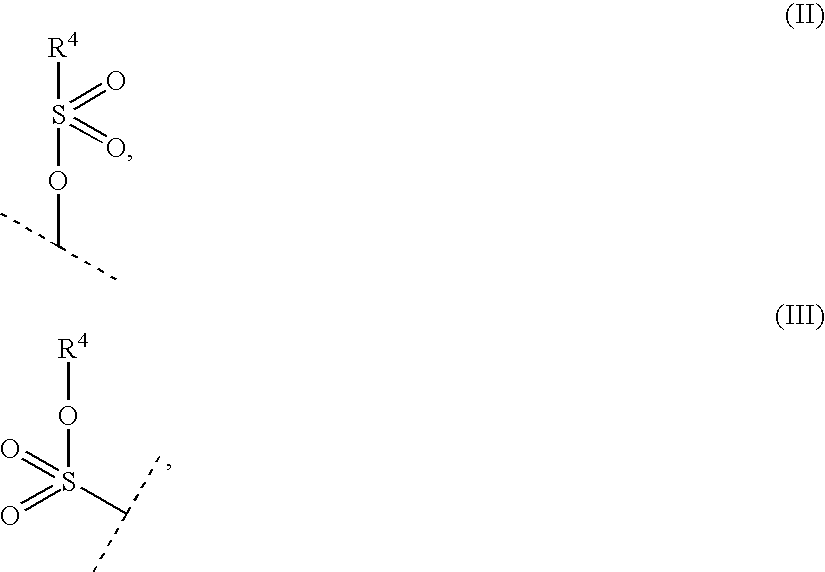New compounds
- Summary
- Abstract
- Description
- Claims
- Application Information
AI Technical Summary
Benefits of technology
Problems solved by technology
Method used
Image
Examples
example 2
2-Chlorophenyl 7-piperazin-1-yl-1-benzofuran-5-sulfonate, trifluoroacetate
[0286] Prepared from 7-iodo-1benzofuran-5-sulfonyl chloride (0.09 g, 0.2 mmol; Intermediate 3) and 2-chlorophenol (0.03 g, 0.2 mmol) by the same method as Example 1 Yield: 0.0036 g (2.5% over 3 steps); HPLC 93%, RT=2.755min (system A, 5-60% MeCN over 3 min); 100%, RT=2.396min (system B, 5-60% MeCN over 3 min); 1H NMR (270 MHz, METHANOL-D4) δ ppm 3.38-3.52 (m, 4 H) 3.52-3.71 (m, 4 H) 7.01 (d, J=2.23 Hz, 1 H) 7.17-7.50 (m, 5 H) 7.84 (d, J=1.73 Hz, 1 H) 7.98 (d, J=2.23 Hz, 1 H); MS (ESI+) for C18H17ClN2O4S m / z 393 (M+H).
example 3
2-(Trifluoromethyl)phenyl 7-piperazin-1-yl-1-benzofuran-5-sulfonate, trifluoroacetate
[0287] Prepared from 7-iodo-1benzofuran-5-sulfonyl chloride (0.095 g, 0.28 mmol; Intermediate 3) and 2-hydroxybenzotrifluoride (0.048 g, 0.29 mmol) by the same method as Example 1. Yield: 0.0031 g (2.1% over 3 steps); HPLC 92%, RT=2.906 min (system A, 5-60% MeCN over 3 min); 97%, RT=2.522 min (system B, 5-60% MeCN over 3 min); 1H NMR (270 MHz, METHANOL-D4) δ ppm 3.44-3.51 (m, 4 H) 3.58-3.66 (m, 4 H) 7.05 (d, J=2.23 Hz, 1 H) 7.34 (d, J=1.48 Hz, 1 H) 7.39-7.49 (m, J=7.55, 7.55 Hz, 1 H) 7.54-7.62 (m, 1 H) 7.62-7.73 (m, J=7.55, 7.55 Hz, 2 H) 7.94 (d, J=1.48 Hz, 1 H) 8.00 (d, J=2.23 Hz, 1 H); MS (ESI+) for C19H17F3N2O4S m / z 427 (M+H).
Intermediate 4
2,3-Dimethoxyphenyl 7-iodo-1-benzofuran-5-sulfonate
[0288]
[0289] To a solution of Intermediate 2 (500 mg, 1 equiv) in chlorobenzene (10 mL) stirred at 80° C. was added AIBN (42 mg, 0.15 equiv), followed by NBS (285 mg, 1.1 equiv) with continued stirring at ...
example 4
Pyridin-3-yl 7-piperazin-1-yl-1-benzofuran-5-sulfonate hydrochloride
[0292]
[0293] t-BOC-piperazine (23 mg, 1 equiv), sodium tert-butoxide (14 mg, 1.2 equiv), Pd2(dba)3 (5 mg, 0.04 equiv), Xantphos (3 mg, 0.04 equiv) were added to a reaction tube and flushed with N2. Intermediate 5 (50 mg, 1 equiv) in (3 mL) xylene was added and the reaction mixture stirred at 120° C. for 4 hrs. The reaction mixture was allowed to cool to rt and then filtered through Celite, eluting with xylene. The filtrate was evaporated to give 40 mg as a pale yellow oil. The residue was purified by Prep LCMS and the pure fractions evaporated. Redissolved in MeOH and added 1 M HCl in diethyl ether to deprotect (i.e., to cleave off the t-BOC group) and convert into HCl-salt, evaporated to give 14.9 mg (28% yield) of the title product as a tan solid: HPLC 93%, RT=1.49 min (System A, 10-97% MeCN over 3 min), 94%, RT=1.35 min (System C, 10-97% MeCN over 3 min); 1H NMR (400 MHz, METHANOL-D4) δ ppm 0.80-0.99 (m, 2 H) 1....
PUM
| Property | Measurement | Unit |
|---|---|---|
| Molar density | aaaaa | aaaaa |
| Molar density | aaaaa | aaaaa |
| Molar density | aaaaa | aaaaa |
Abstract
Description
Claims
Application Information
 Login to View More
Login to View More - R&D
- Intellectual Property
- Life Sciences
- Materials
- Tech Scout
- Unparalleled Data Quality
- Higher Quality Content
- 60% Fewer Hallucinations
Browse by: Latest US Patents, China's latest patents, Technical Efficacy Thesaurus, Application Domain, Technology Topic, Popular Technical Reports.
© 2025 PatSnap. All rights reserved.Legal|Privacy policy|Modern Slavery Act Transparency Statement|Sitemap|About US| Contact US: help@patsnap.com



